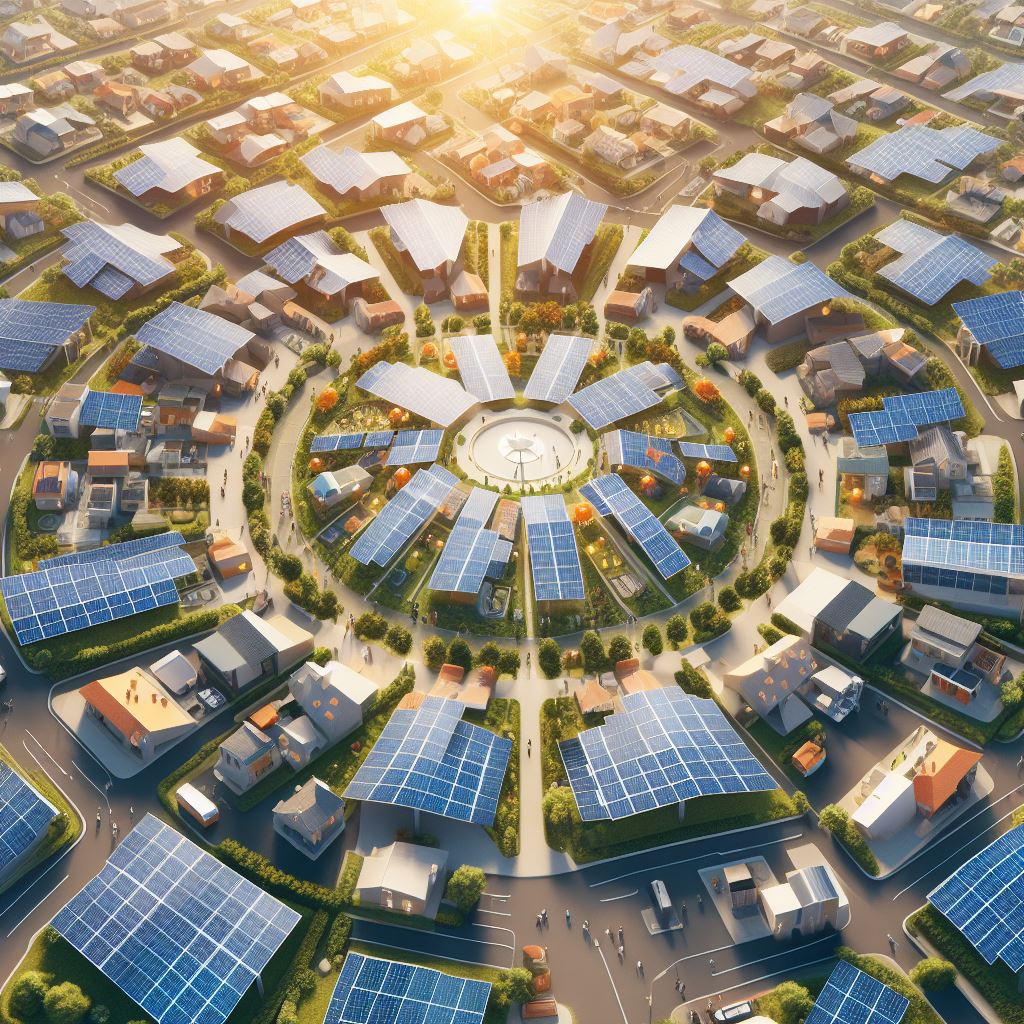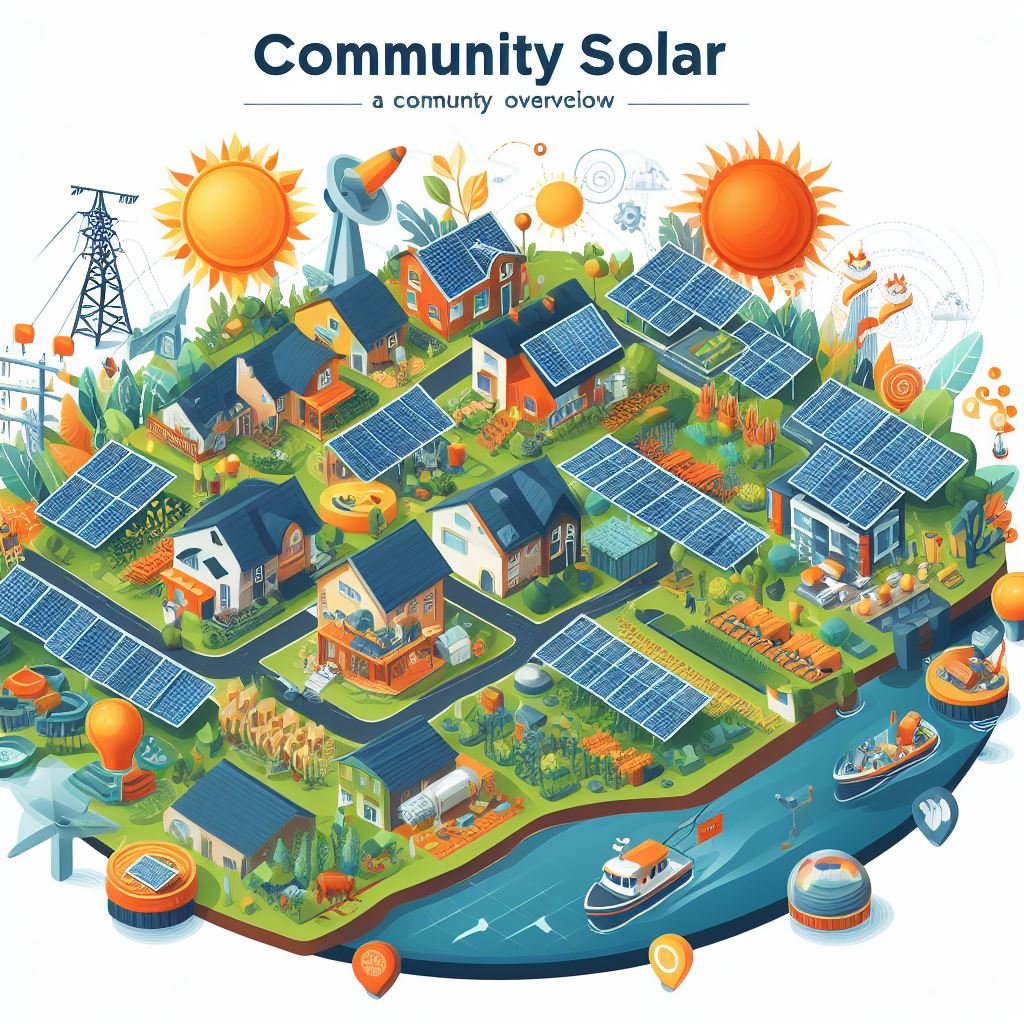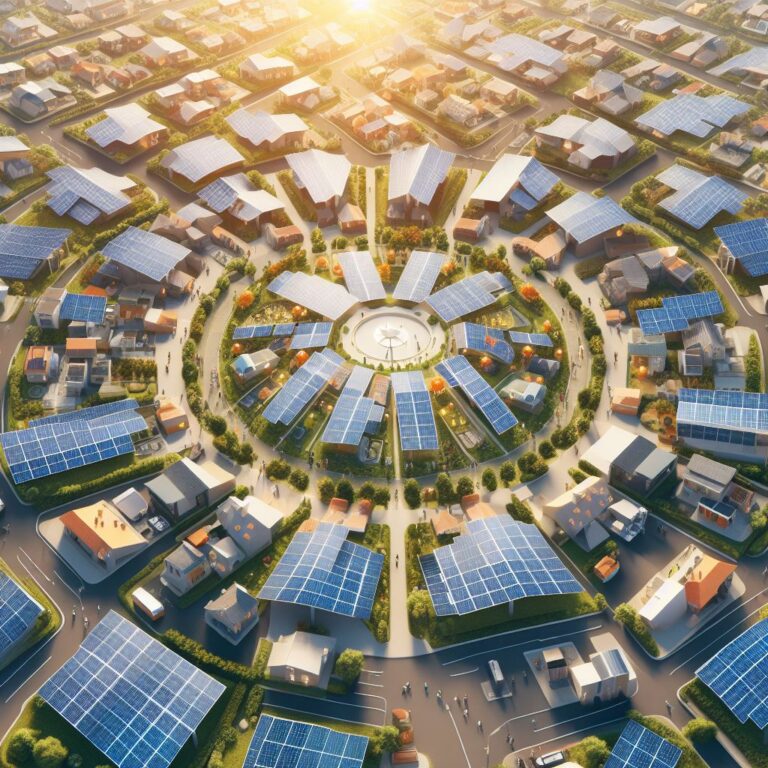Community solar projects are becoming increasingly popular for consumers to access solar power, even if they rent, have shaded roofs, or lack the upfront funds to install private solar panels. In a community solar project, customers subscribe to a portion of a larger, shared solar array and receive credits on their electricity bills proportional to their share.

Shared solar programs allow entire communities to unite behind renewable power, no matter their housing situation or income. This inclusive approach removes the traditional barriers to going solar. Through these programs, participants can cut emissions and utility bills for little upfront cost – just by tapping into a collectively-owned solar installation. As communities band together to adopt clean energy, they build towards a more sustainable and equitable future. Shared solar provides the flexibility and affordability for all to transition away from fossil fuels..
This article provides a detailed overview of community solar, its benefits and limitations, key players in the market, policy and regulatory factors, and the future outlook for the community solar industry.
What is Community Solar?
Community solar allows multiple households to jointly invest in solar energy and split returns as credits on electricity bills. Instead of installing solar panels on their roof, customers subscribe to a portion of a larger, shared array located elsewhere within their electric utility service territory.
Each subscriber’s monthly share of the solar energy produced is credited to their electricity bill, helping offset charges for traditional grid electricity. Subscribers benefit from lower electricity costs and other perks like fixed rates and shared solar tax credits without upfront panel purchase and installation costs. The community solar farm handles all maintenance and operation responsibilities.
Community solar arrays are usually between 500 kW and 5 MW in size and provide power to between 200 and 500 homes. The arrays are built on vacant or agricultural land, rooftops, or brownfield sites. Subscribers can be residential customers, businesses, non-profits, or local government facilities.
How Community Solar Works
There are two main ways customers subscribe to community solar projects:
Purchase a portion of the project: Customers purchase or lease solar panels in the community solar farm proportional to their expected electricity usage. They own that portion of the array.
Subscribe to a share of the project: Customers pay a monthly subscription fee to purchase electricity from the community solar project proportional to their usage. They may subscribe to a kilowatt (kW) block or percentage share of the total output.

No matter the subscription method, as the solar farm generates electricity, energy production is tracked and credited to each subscriber’s electricity bill based on their project share. Customers continue receiving traditional grid power as usual.
For example, a household may subscribe to 10 panels from a 500-panel 100 kW community solar project. When their ten panels produce 500 kWh of electricity that month, a 500 kWh credit will appear on their electricity bill, offsetting costs.
Benefits of Community Solar
Community solar provides a range of benefits:
- Expanded solar access: Around 50% of households are unsuitable for private solar for renting, shading, multi-unit buildings, or lack of capital. Community solar opens solar access to these demographics. Businesses, non-profits, and public entities can subscribe, too.
- Cost savings: On average, subscribers save 10-20% on their electric bills. Savings come from bill credits and sometimes fixed rates.
- Flexibility: Community solar subscriptions can begin or end anytime, with no long-term contract. Panels can also be shared between family or friends.
- Supporting clean energy: Community solar expands renewable energy generating capacity and reduces fossil fuel dependence and greenhouse gas emissions.
- Local investment: Projects create local green jobs, and the arrays provide stable power pricing. Some projects reinvest revenues into the community.
- Minimal responsibilities: The solar provider handles panel maintenance, operations, permitting, billing credits, and other responsibilities.
Drawbacks and Challenges Facing Community Solar
However, community solar does come with some limitations:
- Upfront costs: While long-term savings are possible, subscriptions often involve fees and deposits upfront that are still out of reach for many families.
- Complex policies: Regulations around community solar billing credits, grid interconnection, subscription models, and other factors are still developing, causing uncertainty.
- Siting difficulties: Finding ideal open land conducive to solar with grid connections is becoming more difficult and costly.
- Subscriber acquisition: Attracting enough customers to subscribe to portions of a proposed project can be challenging and slow initial development.
- Tax credit restrictions: Residential tax credits are only available if the subscriber owns their portion of the array directly, not via a subscription model.
- Grid limitations: High penetrations of community solar, if not managed well, can strain local grids. However, utilities and developers are actively finding solutions.
Key Players in Community Solar Projects
Developing and operating a community solar project involves multiple key partners:
- Project developers: Specialized solar development companies originate, develop, and manage community solar projects. Some are affiliates of investor-owned utilities.
- Tax equity investors: Tax equity investors like banks and institutions provide capital to projects in exchange for tax credits. This lowers financing costs.
- Subscribers: The customers purchasing or leasing a portion of the project or subscribing to the output. Subscribers are often located within a few miles of the solar installation.
- Utility companies: The local utility integrates the community solar plant with the grid, credits subscribers, and maintains grid reliability.
- Solar manufacturers: Manufacturers produce solar panels, inverters, racking and other equipment. Economies of scale reduce hardware costs.
- Landowners: Owners of vacant or unused land lease space to community solar developers through long-term contracts. The ideal land is near transmission lines.
- Local jurisdictions: City, county, and state entities provide permits, grid interconnections, renewable incentives and help shape policy.
Community Solar Policy and Regulations
The policy environment for community solar is determined largely at the state level but also involves federal tax credits and utility policies. Key factors shaping the sector include:

- Virtual net metering: Required in 38 states, this credits solar value to subscribers’ bills no matter the location of the array. It is foundational for the community solar model.
- Grid connection policies: Rules for connecting projects to the grid impact costs. Some states have streamlined processes.
- Project size limits: Program caps restricting the maximum size of community solar installations artificially limit market growth.
- Subscriber requirements: Rules around subscriber location, demographics, sharing subscriptions, and ownership models dictate markets.
- Unsubscribed energy: Compensation rates for unallocated project portions impact bankability.
- Utility-led vs. third party: Rules allowing independent solar developers versus restricting projects to utility affiliates impacts competition.
- Incentives and tax credits: Federal and state tax credits, grants, and renewable incentives help offset costs to spur development.
Outlook for Community Solar Growth
Community solar capacity is projected to expand rapidly over the next five years. According to analysts, the U.S. market will grow from 3.9 GW at the end of 2020 to over 7 GW by 2025, expanding access to solar for millions more consumers.
Several key factors are expected to drive continued strong growth:
- Expanding state policies supporting virtual net metering, community access, and fair credit rates.
- Utilities incorporating community solar into their renewable energy strategies
- Increased financing availability and lower capital costs as the model matures.
- Ongoing local government and consumer demand for affordable clean energy options.
- Community Solar’s alignment with corporate sustainability and carbon reduction goals.
However, to fully unlock the promise of community solar, key challenges around expanding access to low and moderate-income families must still be addressed. With supportive policies and falling solar costs, community solar offers an increasingly compelling solution for cities, communities, and businesses seeking to go green.
Community Solar vs Rooftop Solar Comparison
| Community Solar | Rooftop Solar | |
|---|---|---|
| Costs | Little or no upfront costs. Monthly subscription | High upfront system purchase and installation costs |
| fees. May require long term contract | ||
| Site | Large shared ground or roof array, offsite | Small private array on home roof |
| Ownership | Own or lease portion of project or subscribe to | Homeowner owns full rooftop system |
| electricity share | ||
| System Size | Large scale, 500 kW – 5 MW | Residential: 5-10 kW Commercial 30-100 kW on avg |
| Maintenance | Handled by solar provider | Owner responsibility |
| Eligibility | Open to renters, apartments, businesses | Limited to suitable private homes and buildings |
| Upfront Commitment | Flexible subscribing, leaving, sharing access | 20+ year system lifespan with high upfront cost |
| Energy Supply | Receive bill credits for solar share | Solar self-consumption, net metering exports excess |
| Tax Incentives | May utilize tax equity financing partnerships | Full access to ITC and solar tax credits |
Frequently Asked Questions
How much do community solar subscriptions cost?
Subscription costs vary by location, system size, and subscriber type. Residential subscriptions can range from $10-30 monthly for each kW block or panel share. Actual savings depend on retail electricity rates and solar value credit rates.
Who owns the community solar array?
Projects are owned by an independent solar developer, a utility, or a joint partnership. Subscribers own or lease a portion of the physical array.
Where are community solar projects located?
Systems are sited on open land near existing transmission infrastructure, usually within the same utility service territory as subscribers. Locations include brownfields, industrial land, agricultural areas, and commercial rooftops.
Can I cancel my community solar subscription?
Most providers only require 30 days’ notice to cancel without penalty. Shorter subscriptions and contract terms create flexibility.
Do I need to live near the community solar array?
Proximity requirements vary by state policy, but subscribers generally live within the same utility territory, if not the same town or county, as the installation.
How are community solar credits calculated?
Credit calculation methods, like net metering rates and the value of solar, depend on state policies. Subscribers receive credits proportional to their share of the project’s output.
Can community solar save me money?
Subscriptions typically save participants 10-20% on their electricity bills. The stability of credit rates can also hedge against utility rate increases.

9 Comments
Pingback: Building a Cleaner Future: Sustainable Living to Reduce Pollution - wrxnews.com
Pingback: Government Incentives For Renewable Energy: Policies Driving Growth - Wrxnews.com
Pingback: Solar Energy Financing Options: A Comprehensive Guide - Wrxnews.com
Pingback: Where We Stand On Climate Change 2024 ? - Wrxnews.com
Заказать двери на заказ в Москве
Изготовление дверей на заказ по индивидуальным размерам
Советы по выбору дверей на заказ
Материалы и цвета дверей на заказ
Двери на заказ: доставка и монтаж дверей на заказ
Экономичные варианты дверей на заказ
Шпонированные двери на заказ: преимущества и недостатки
Металлические двери на заказ: надежность и безопасность
Двери на заказ у мастеров-ремесленников
Купить двери по размерам [url=http://mebel-finest.ru/]http://mebel-finest.ru/[/url].
Pingback: The Future Of Renewable Energy: Trends, Projections And Emerging Technologies - Wrxnews.com
Pingback: Benefits Of Solar Energy Wrxnews.com
Качественная уборка квартиры в Новосибирске от профессионалов
Мытье квартиры [url=https://www.chisty-list.online]https://www.chisty-list.online[/url].
Экспресс уборка квартиры в СПб: Наша команда готова вам помочь
Услуги уборки квартир санкт петербург [url=http://www.chisty-list.ru]http://www.chisty-list.ru[/url].